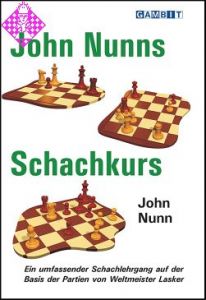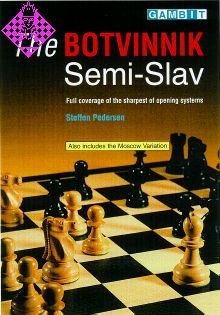Artikelnummer
LOPEDTBSS
Autor
The Botvinnik Semi-Slav
Also includes the Moscow Variation
192 Seiten, kartoniert, Gambit, 1. Auflage 2000
Final vergriffen
The Semi-Slav has been one of the most topical openings of the last decade, and its most critical variation is the Botvinnik System (5 Bg5 dxc4). Most of today's top grandmasters, including Kasparov, Kramnik and Shirov, have relied on it as Black, White or both, especially in make-or-break situations.
Black creates immediate imbalance by establishing a big queenside majority, at the cost of major damage to his kingside. Black tends to possess the long-term trumps, so the main lines see White launching a massive attack against the black king. Black's standard response is counterattack, and positions with bizarre material imbalances arise almost as a matter of course.
To play such an opening successfully, one requires a firm grounding in the underlying principles (such as there are!) and a detailed knowledge of specific variations. This book provides both. The author is a well-known theoretician and player who has had a strong interest in the Botvinnik System for many years - for instance the move 18...d4, which became the 'main line' in 1998, was first suggested by Pedersen in 1994.
Pedersen also discusses in depth the Moscow Variation (5 Bg5 h6), which is a calmer option for Black, and a favourite of Anand and Dreev. This book therefore provides comprehensive coverage of 5 Bg5 versus the Semi-Slav.
Black creates immediate imbalance by establishing a big queenside majority, at the cost of major damage to his kingside. Black tends to possess the long-term trumps, so the main lines see White launching a massive attack against the black king. Black's standard response is counterattack, and positions with bizarre material imbalances arise almost as a matter of course.
To play such an opening successfully, one requires a firm grounding in the underlying principles (such as there are!) and a detailed knowledge of specific variations. This book provides both. The author is a well-known theoretician and player who has had a strong interest in the Botvinnik System for many years - for instance the move 18...d4, which became the 'main line' in 1998, was first suggested by Pedersen in 1994.
Pedersen also discusses in depth the Moscow Variation (5 Bg5 h6), which is a calmer option for Black, and a favourite of Anand and Dreev. This book therefore provides comprehensive coverage of 5 Bg5 versus the Semi-Slav.
The Semi-Slav has been one of the most topical openings of the last decade, and its most critical variation is the Botvinnik System (5 Bg5 dxc4). Most of today's top grandmasters, including Kasparov, Kramnik and Shirov, have relied on it as Black, White or both, especially in make-or-break situations.
Black creates immediate imbalance by establishing a big queenside majority, at the cost of major damage to his kingside. Black tends to possess the long-term trumps, so the main lines see White launching a massive attack against the black king. Black's standard response is counterattack, and positions with bizarre material imbalances arise almost as a matter of course.
To play such an opening successfully, one requires a firm grounding in the underlying principles (such as there are!) and a detailed knowledge of specific variations. This book provides both. The author is a well-known theoretician and player who has had a strong interest in the Botvinnik System for many years - for instance the move 18...d4, which became the 'main line' in 1998, was first suggested by Pedersen in 1994.
Pedersen also discusses in depth the Moscow Variation (5 Bg5 h6), which is a calmer option for Black, and a favourite of Anand and Dreev. This book therefore provides comprehensive coverage of 5 Bg5 versus the Semi-Slav.
Black creates immediate imbalance by establishing a big queenside majority, at the cost of major damage to his kingside. Black tends to possess the long-term trumps, so the main lines see White launching a massive attack against the black king. Black's standard response is counterattack, and positions with bizarre material imbalances arise almost as a matter of course.
To play such an opening successfully, one requires a firm grounding in the underlying principles (such as there are!) and a detailed knowledge of specific variations. This book provides both. The author is a well-known theoretician and player who has had a strong interest in the Botvinnik System for many years - for instance the move 18...d4, which became the 'main line' in 1998, was first suggested by Pedersen in 1994.
Pedersen also discusses in depth the Moscow Variation (5 Bg5 h6), which is a calmer option for Black, and a favourite of Anand and Dreev. This book therefore provides comprehensive coverage of 5 Bg5 versus the Semi-Slav.
| EAN | 9781901983265 |
|---|---|
| Gewicht | 300 kg |
| Hersteller | Gambit |
| Breite | 14,5 cm |
| Höhe | 21 cm |
| Medium | Buch |
| Erscheinungsjahr | 2000 |
| Autor | Steffen Pedersen |
| Sprache | Englisch |
| Auflage | 1 |
| ISBN-10 | 1901983269 |
| ISBN-13 | 9781901983265 |
| Seiten | 192 |
| Einband | kartoniert |
| Diagramme | 200 |
4 Symbols
5 Bibliography
6 Foreword
Part One: The Botvinnik System (5 Lg5 dxc4)
7 1 Introduction to the Botvinnik System
10 2 The Main Line: 17 a3
38 3 16...Da6 and 16...Dd6
44 4 Uhlmann's 16 Tb1
58 5 Black's 13th Move Alternatives
78 6 Ideas with ...Da5
86 7 Move-orders and Various Deviations
106 8 10...Le7
116 9 Alatortsev's 9...Sd5?!
127 10 White Gambits: 9 exf6!?
141 11 7 a4
151 12 Early Deviations (6 e3 and 6 a4)
Part Two: The Moscow Variation (5 Lg5 h6)
156 13 Introduction to the Moscow Variation
157 14 The Anti-Moscow Variation: 6 Lh4!?
181 15 The Main Line: 6 Lxf6 Dxf6 7.e3 Sd7 8.Ld3 dxc4
203 16 Black's 8th Move Alternatives
210 17 Deviations from the Main Line
221 18 Odds and Ends
222 Index of Variations
5 Bibliography
6 Foreword
Part One: The Botvinnik System (5 Lg5 dxc4)
7 1 Introduction to the Botvinnik System
10 2 The Main Line: 17 a3
38 3 16...Da6 and 16...Dd6
44 4 Uhlmann's 16 Tb1
58 5 Black's 13th Move Alternatives
78 6 Ideas with ...Da5
86 7 Move-orders and Various Deviations
106 8 10...Le7
116 9 Alatortsev's 9...Sd5?!
127 10 White Gambits: 9 exf6!?
141 11 7 a4
151 12 Early Deviations (6 e3 and 6 a4)
Part Two: The Moscow Variation (5 Lg5 h6)
156 13 Introduction to the Moscow Variation
157 14 The Anti-Moscow Variation: 6 Lh4!?
181 15 The Main Line: 6 Lxf6 Dxf6 7.e3 Sd7 8.Ld3 dxc4
203 16 Black's 8th Move Alternatives
210 17 Deviations from the Main Line
221 18 Odds and Ends
222 Index of Variations
The Botvinnik Semi-Slav by Steffen Pedersen aims to offer a comprehensive survey of current Botvinnik System (1.d4 d5 2.c4 c6 3.Sf3 Sf6 4.Sc3 e6 5.Lg5 dc4) and Moscow Variation (1.d4 d5 2.c4 c6 3.Sf3 Sf6 4.Sc3 e6 5. Lg5 h6) theory... and succeeds! As well as providing excellent theoretical coverage of the most fashionable lines, the author has also clearly put a lot of effort into trying to revalidate the unfashionable 5...dc4 6.e4 b5 7.e5 h6 8.Lh4 g5 9.Sg5 Sd5 and 9...hg5 10.Lg5 Le7 lines. The only criticism I can make about the book is that there are a number of places where the relative importance of variations within each chapter could have been much more clearly stated. For example, in the chapter on 5...dc4 6.e4 b5 7.e5 h6 8.Lh4 g5 9.ef6 gh4 10.Se5 Df6, the author gives three lines - 11.g3, 11.Le2 and 11.a4. 11.a4 is presented as the main line but leads to a clear advantage for Black in several variations. 11.g3 by contrast is given only a small amount of attention but leads to a crushing White position. This small gripe aside, this book is highly recommended for anyone crazy enough to play the Botvinnik!Matthew Sadler, New in Chess Magazine 2/2000
The Botvinnik Semi-Slav by Steffen Pedersen aims to offer a comprehensive survey of current Botvinnik System (1. d4 d5 2. c4 c6 3. Sf3 Sf6 4. Sc3 e6 5. Lg5 dc4) and Moscow Variation (1. d4 d5 2. c4 c6 3. Sf3 Sf6 4. Sc3 e6 5. Lg5 h6) theory... and succeeds! As well as providing excellent theoretical coverage of the most fashionable lines, the author has also clearly put a lot of effort into trying to revalidate the unfashionable 5. ...dc4 6. e4 b5 7. e5 h6 8. Lh4 g5 9. Sg5 Sd5 and 9. ...hg5 10. Lg5 Le7 lines. The only criticism I can make about the book is that there are a number of places where the relative importance of variations within each chapter could have been much more clearly stated. For example, in the chapter on 5. ...dc4 6. e4 b5 7. e5 h6 8. Lh4 g5 9. ef6 gh4 10. Se5 Df6, the author gives three lines - 11. g3, 11. Le2 and 11. a4. 11. a4 is presented as the main line but leads to a clear advantage for Black in several variations. 11. g3 by contrast is given only a small amount of attention but leads to a crushing White position. This small gripe aside, this book is highly recommended for anyone crazy enough to play the Botvinnik !Matthew Sadler, New in Chess Magazine 2/2000
Der junge dänische IM Steffen Pedersen hat als Schach-Autor bereits eine beachtliche Erfahrung gesammelt, stammen von ihm doch schon Eröffnungsbücher über Holländisch, die Scheveninger Variante im Sizilianer und über das Benkö-Gambit.
Sein neuestes Werk befasst sich mit einer der schärfsten und komplexesten Spielweisen, dem Botwinnik-System im Halb-Slawisch 1. d4 d5 2. c4 c6 3. Sf3 Sf6 4. Sc3 e6 5. Lg5 d:c4; zudem behandelt er die Moskauer Variante 5. Lg5 h6.
Pedersen baut die einzelnen Kapitel alle nach dem gleichen Schema auf: Zunächst gibt er eine allgemeine Einführung in die Variante, sodann führt er markante Beispiele auf und erläutert spezifische Bauernstrukturen, und schließlich - nach einer kurzen zusammenfassenden Beurteilung - behandelt er detailliert die neueste Theorie des Abspiels.
Auf diese Weise befasst er sich systematisch mit dem Botwinnik-System (Teil 1):
1) Einführung (S. 7-9);
2) Hauptvariante 1. d4 d5 2. c4 c6 3. Sf3 Sf6 4. Sc3 e6 5. Lg5 d:c4 6. e4 b5 7. e5 h6 8. Lh4 g5 9. S:g5 h:g5 10. L:g5 Sbd7 11. e:f6 Lb7 12. g3 Db6 13. Lg2 c5 14. d5 0-0-0 15. 0-0 b4 16. Sa4 Db5 17. a3 (S. 10-37);
3) 16. ...Da6 und 16. ...Dd6 - nicht zu empfehlen (S. 38-43);
4) Uhlmanns Zug 16. Tb1 (S. 44-57);
5) Schwarze Alternativen im 11. Zug: 13. ...Sb6, 13. ...Se5, 13. ...S:f6 und 13. ...Lh6 (S. 58-77);
6) Ideen mit 11. ...Da5 (S. 78-85);
7) Abweichungen im 11. Zug: 11. g3 und 11. e:f6 (S. 86-105);
8) Der Zug 10. ...Le7 (S. 106-115);
9) Alatortzews Zug 9. ...Sd5?! (S. 116-126);
10) Weiße Gambitfortsetzungen nach 9. e:f6!? (S. 127-140);
11) Der Zug 7. a4 (S. 141-150);
12) Frühe Abweichungen mit 6. e3 und 6. a4 (S. 151-155).
Die Moskauer Variante gliedert der Autor in folgende Abschnitte (Teil 2):
1) Einführung (S. 156);
2) Die Anti-Moskau-Variante 1. d4 d5 2. c4 c6 3. Sf3 Sf6 4. Sc3 e6 5. Lg5 h6 6. Lh4!? (S. 157-180), welche nach dem gegenwärtigen Stand der Theorie ganz vielversprechend für Weiß auszusehen scheint;
3) Die Hauptvariante 6. L:f6 D:f6 7. e3 Sd7 8. Ld3 d:c4 (S. 181-202), führt zu langwierigem strategischen Manövrierspiel;
4) Schwarze Alternativen im 8. Zug: 8. ...g6, 8. ...Ld6, 8. ...Dd8 (S. 203-209);
5) Abweichungen von der Hauptvariante mit 7. g3, 7. Dc2, 7. Db3 und 7. e3 (S. 210-220).
Was aber, wenn Schwarz auf 5. Lg5 einfach 5. ...Sbd7 (mit Übergang zur Cambridge-Springs-Variante) oder 5. ...Le7 (klassisches Damengambit) spielt (S. 221)? Nun, dann fallen sämtliche im Buch geschilderten faszinierenden und höchst komplizierten Möglichkeiten weg und die klassischen Damengambit-Stellungsbilder kommen aufs Tapet.
Gleichwohl ist der Band theoriebeflissenen Spielern, welche die Ungewissheit und phantastische Verwicklungen bis weit in das Mittelspiel hinein lieben und nebenbei die englische Sprache verstehen, zum intensiven Studium sehr zu empfehlen.
Der stolze Preis erklärt sich durch den derzeitigen hohen Wechselkurs des britischen Pfundes.
Dr. W. Schweizer / Rochade Europa 6/2000
Der junge dänische IM Steffen Pedersen hat als Schach-Autor bereits eine beachtliche Erfahrung gesammelt, stammen von ihm doch schon Eröffnungsbücher über Holländisch, die Scheveninger Variante im Sizilianer und über das Benkö-Gambit.
Sein neuestes Werk befasst sich mit einer der schärfsten und komplexesten Spielweisen, dem Botwinnik-System im Halb-Slawisch 1. d4 d5 2. c4 c6 3. Sf3 Sf6 4. Sc3 e6 5. Lg5 d:c4; zudem behandelt er die Moskauer Variante 5. Lg5 h6.
Pedersen baut die einzelnen Kapitel alle nach dem gleichen Schema auf: Zunächst gibt er eine allgemeine Einführung in die Variante, sodann führt er markante Beispiele auf und erläutert spezifische Bauernstrukturen, und schließlich - nach einer kurzen zusammenfassenden Beurteilung - behandelt er detailliert die neueste Theorie des Abspiels.
Auf diese Weise befasst er sich systematisch mit dem Botwinnik-System (Teil 1):
1) Einführung (S. 7-9);
2) Hauptvariante 1. d4 d5 2. c4 c6 3. Sf3 Sf6 4. Sc3 e6 5. Lg5 d:c4 6. e4 b5 7. e5 h6 8. Lh4 g5 9. S:g5 h:g5 10. L:g5 Sbd7 11. e:f6 Lb7 12. g3 Db6 13. Lg2 c5 14. d5 0-0-0 15. 0-0 b4 16. Sa4 Db5 17. a3 (S. 10-37);
3) 16. ...Da6 und 16. ...Dd6 - nicht zu empfehlen (S. 38-43);
4) Uhlmanns Zug 16. Tb1 (S. 44-57);
5) Schwarze Alternativen im 11. Zug: 13. ...Sb6, 13. ...Se5, 13. ...S:f6 und 13. ...Lh6 (S. 58-77);
6) Ideen mit 11. ...Da5 (S. 78-85);
7) Abweichungen im 11. Zug: 11. g3 und 11. e:f6 (S. 86-105);
8) Der Zug 10. ...Le7 (S. 106-115);
9) Alatortzews Zug 9. ...Sd5?! (S. 116-126);
10) Weiße Gambitfortsetzungen nach 9. e:f6!? (S. 127-140);
11) Der Zug 7. a4 (S. 141-150);
12) Frühe Abweichungen mit 6. e3 und 6. a4 (S. 151-155).
Die Moskauer Variante gliedert der Autor in folgende Abschnitte (Teil 2):
1) Einführung (S. 156);
2) Die Anti-Moskau-Variante 1. d4 d5 2. c4 c6 3. Sf3 Sf6 4. Sc3 e6 5. Lg5 h6 6. Lh4!? (S. 157-180), welche nach dem gegenwärtigen Stand der Theorie ganz vielversprechend für Weiß auszusehen scheint;
3) Die Hauptvariante 6. L:f6 D:f6 7. e3 Sd7 8. Ld3 d:c4 (S. 181-202), führt zu langwierigem strategischen Manövrierspiel;
4) Schwarze Alternativen im 8. Zug: 8. ...g6, 8. ...Ld6, 8. ...Dd8 (S. 203-209);
5) Abweichungen von der Hauptvariante mit 7. g3, 7. Dc2, 7. Db3 und 7. e3 (S. 210-220).
Was aber, wenn Schwarz auf 5. Lg5 einfach 5. ...Sbd7 (mit Übergang zur Cambridge-Springs-Variante) oder 5. ...Le7 (klassisches Damengambit) spielt (S. 221)? Nun, dann fallen sämtliche im Buch geschilderten faszinierenden und höchst komplizierten Möglichkeiten weg und die klassischen Damengambit-Stellungsbilder kommen aufs Tapet.
Gleichwohl ist der Band theoriebeflissenen Spielern, welche die Ungewissheit und phantastische Verwicklungen bis weit in das Mittelspiel hinein lieben und nebenbei die englische Sprache verstehen, zum intensiven Studium sehr zu empfehlen.
Der stolze Preis erklärt sich durch den derzeitigen hohen Wechselkurs des britischen Pfundes.
Dr. W. Schweizer / Rochade Europa 6/2000
Mehr von Gambit
-
 Schachendspiele in der Praxis23,95 €
Schachendspiele in der Praxis23,95 € -
 John Nunns Schachkurs17,95 €
John Nunns Schachkurs17,95 € -
 Schachstrategie in Aktion23,95 €
Schachstrategie in Aktion23,95 € -
 Chess Strategy for Kids16,50 €
Chess Strategy for Kids16,50 € -
 How to beat your dad at chess14,95 €
How to beat your dad at chess14,95 € -
 Chess Puzzles for Kids14,95 €
Chess Puzzles for Kids14,95 € -
 Schacheröffnungen für Kids14,95 €
Schacheröffnungen für Kids14,95 € - Mehr von Gambit

